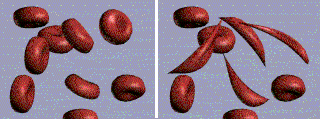Sickle Cell Disease
Sickle cell disease includes a group of related disorders that affect a person's red blood cells. It is caused by a change in the genes that make hemoglobin which is the substance in red blood cells that carries oxygen. 
With sickle cell disease, a person's red blood cells can become hard, sticky, and sickle shaped. The blood cells look curved or have a rounded bend or crescent shape. In a healthy person, red blood cells have a round, donut shape.
There are several types of sickle cell disease, the most common being Sickle Cell Anemia (Hb SS Disease). Other types of sickle cell disease are caused by different variations in hemoglobin that in combination with hemoglobin S may cause problems.
Hemoglobin disorders (also known as hemoglobinopathies) are rare blood conditions that affect a person’s hemoglobin.
Sickle Cell Disorders and COVID-19: Why My Child Needs a COVID-19 Vaccine (PDF)
Newborn Screening for SCD
In 1983, the Texas Newborn Screening Program began screening newborns for SCD. Blood samples are collected from a heel stick done 24 to 48 hours after birth and again at 1 to 2 weeks of age. The samples are sent to the DSHS Laboratory for screening. Symptoms of SCD usually appear when an infant is around 5 months old. Early diagnosis helps parents access information and specialty health care for their child.
In Texas, approximately one out of every 2,000 newborns has SCD. SCD predominantly affects Black families, who make up an average of 85% of cases in Texas over the last few years. Hispanics account for about 5%, and other ethnicities combined make up the other 10%.
SCD worsens over time. Evolving treatments can decrease complications and improve a person’s life. These treatments include stem cell transplantation, gene therapy and new drugs approved by the Food and Drug Administration.
“This is an exciting time for people living with sickle cell disease,” said Dr. Melissa Frei-Jones, vice chair of the DSHS Newborn Screening Advisory Committee and member of the Sickle Cell Task Force. “We now have three new medications, in addition to hydroxyurea, and our understanding of potentially curative therapies, such as bone marrow transplant, and gene therapy is rapidly growing. However, it is important to not lose sight of the significance that less than five years ago, this disease, which affects more than 100,000 Americans, only had one approved medication. We must continue to raise awareness of sickle cell advocating for increased research funding, access to comprehensive medical care and improved quality of life.”
To learn more about SCD, watch this video featuring Dr. Titilope Fasipe and visit the DSHS Sickle Cell Disease and Centers for Disease Control and Prevention Sickle Cell Disease webpages.
To read more about new therapies, access this journal article in the medical journal Ethnicity & Disease and this article in the Mediterranean Journal of Hematology and Infectious Diseases.
Who It Affects
It affects males and females equally. Sickle cell disease is inherited. That means it is passed from mothers and fathers to their children when both parents have the disease or trait. It is not contagious meaning it is not spread by touching or being close to someone who has this condition.
People of many ethnic groups can have sickle cell disease. It is most common in persons of African descent, but it is also found in persons whose ancestors come from Asia, India, Indigenous America, Latin America, Mediterranean, and Middle East regions. All Texas newborns are screened for sickle cell disease as well as more than 50 other conditions.
What Happens
People with sickle cell disease have periods of well-being and stages of illness. The periods of illness are called sickle cell crises. Sickle cell disease can cause serious health complications that can include pneumonia, organ damage, swelling of hands and feet, chest pains and trouble breathing, blood in urine, fever, stroke, leg ulcers, infections, jaundice, gallstones, anemia, as well as painful erections in men and complications during pregnancy.
Early treatment is essential. Some treatments are still being researched. Sickle cell disease can be controlled by:
- Medications
- Blood transfusions
- Oxygen therapy
- Intravenous fluids
- Vitamin supplements
It can be cured by a bone marrow transplant.
More about Sickle Cell Disease
Learn more about sickle cell disease including information for parents and healthcare providers, other types of hemoglobin conditions, and potential complications.
Sickle Cell Resources
View sickle cell resources including consultant and provider lists, educational information and videos, direct service and support organizations as well as other information.
Sickle Cell Trait
Learn about sickle cell trait which is a blood condition in which a person inherits one gene with normal hemoglobin and one with sickle hemoglobin.
What is Sickle Cell Disease and how can you support individuals with this disorder?
Dr. Titilope Fasipe, MD, Ph.D., breaks down these questions and more. Dr. Fasipe is the Co-Director of the Sickle Cell & Thalassemia Program at Texas Children’s Hospital and Assistant Professor at Baylor College of Medicine. She is also a DSHS Newborn Screening Advisory Committee member and the Sickle Cell Task Force Chair.
